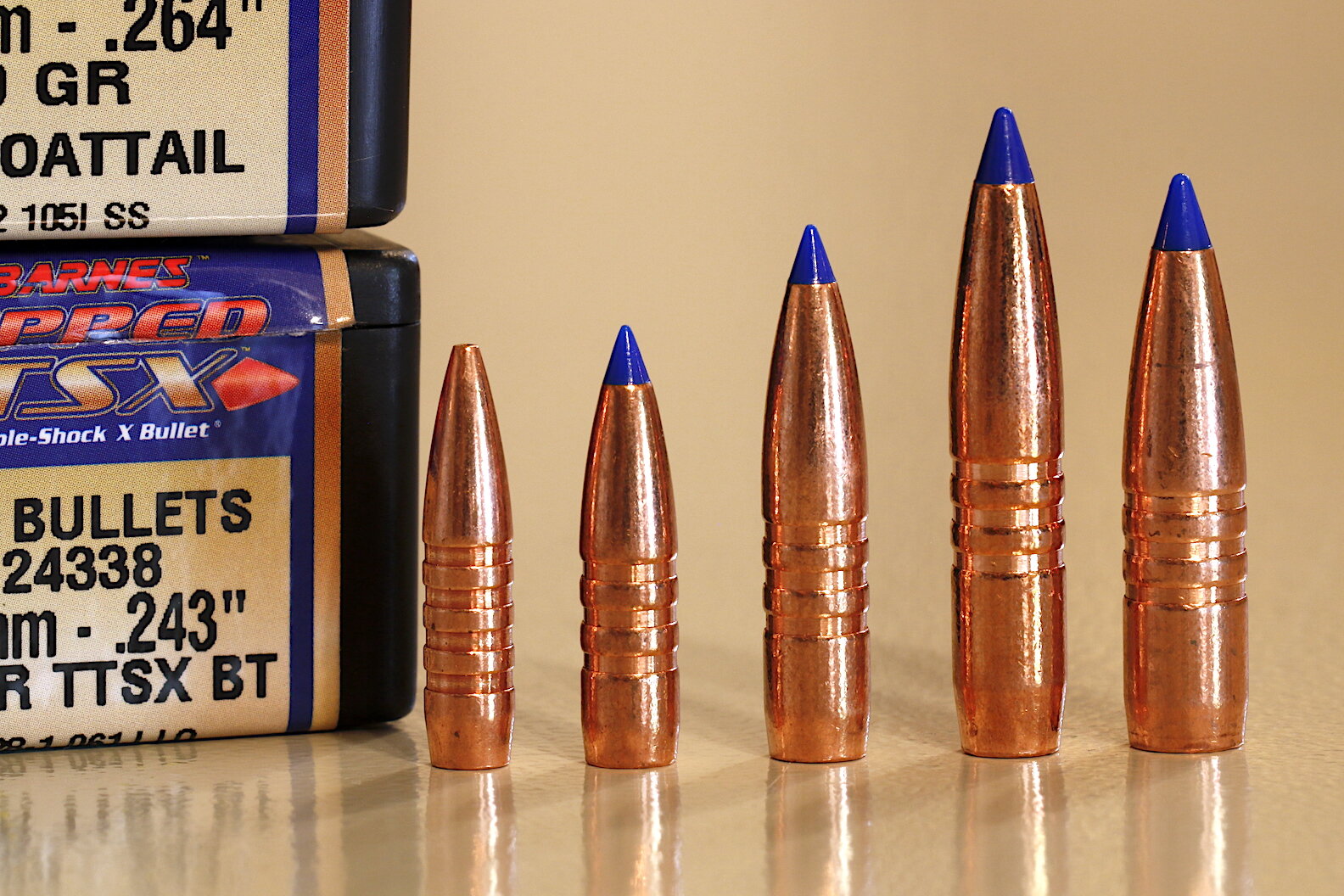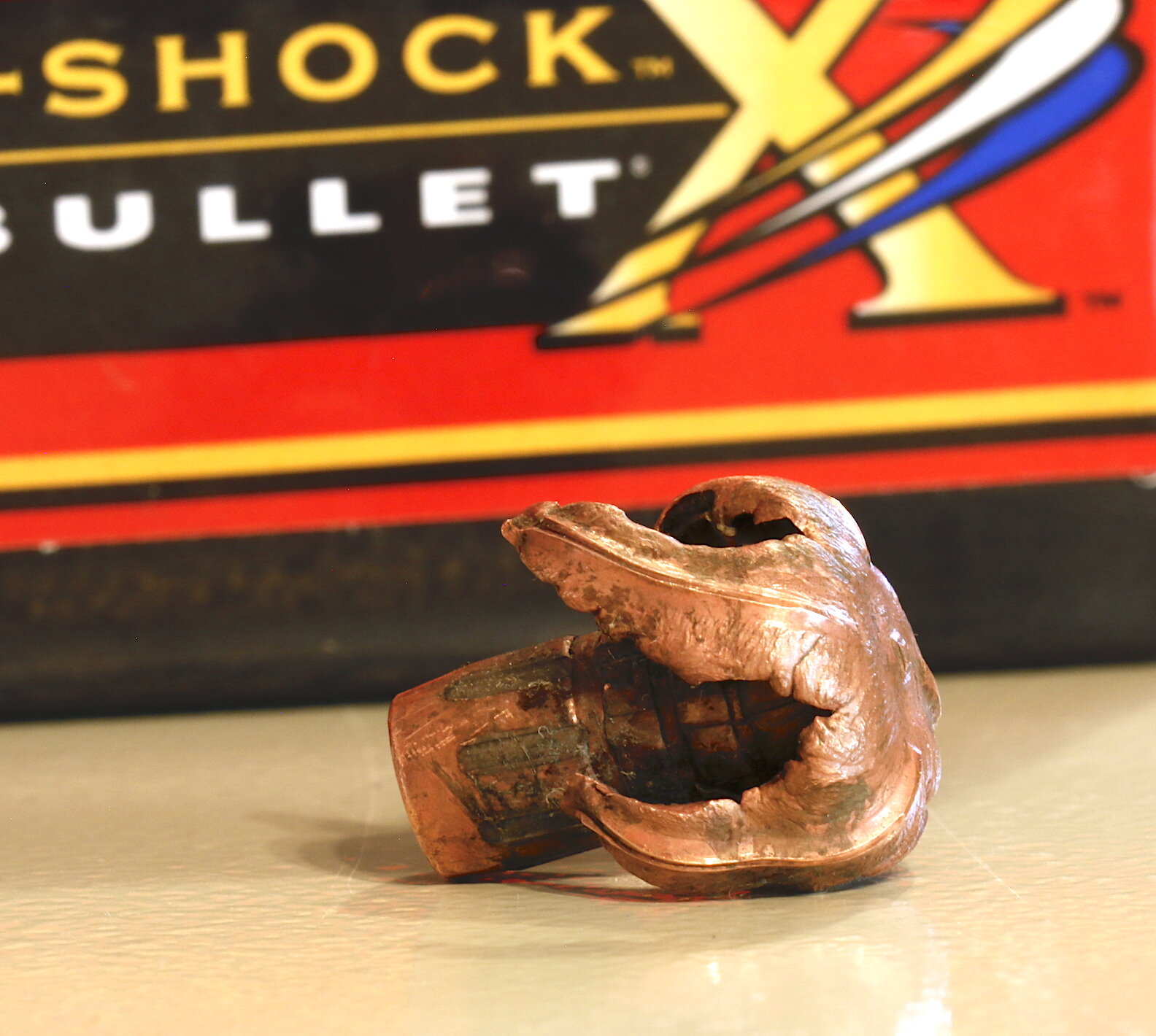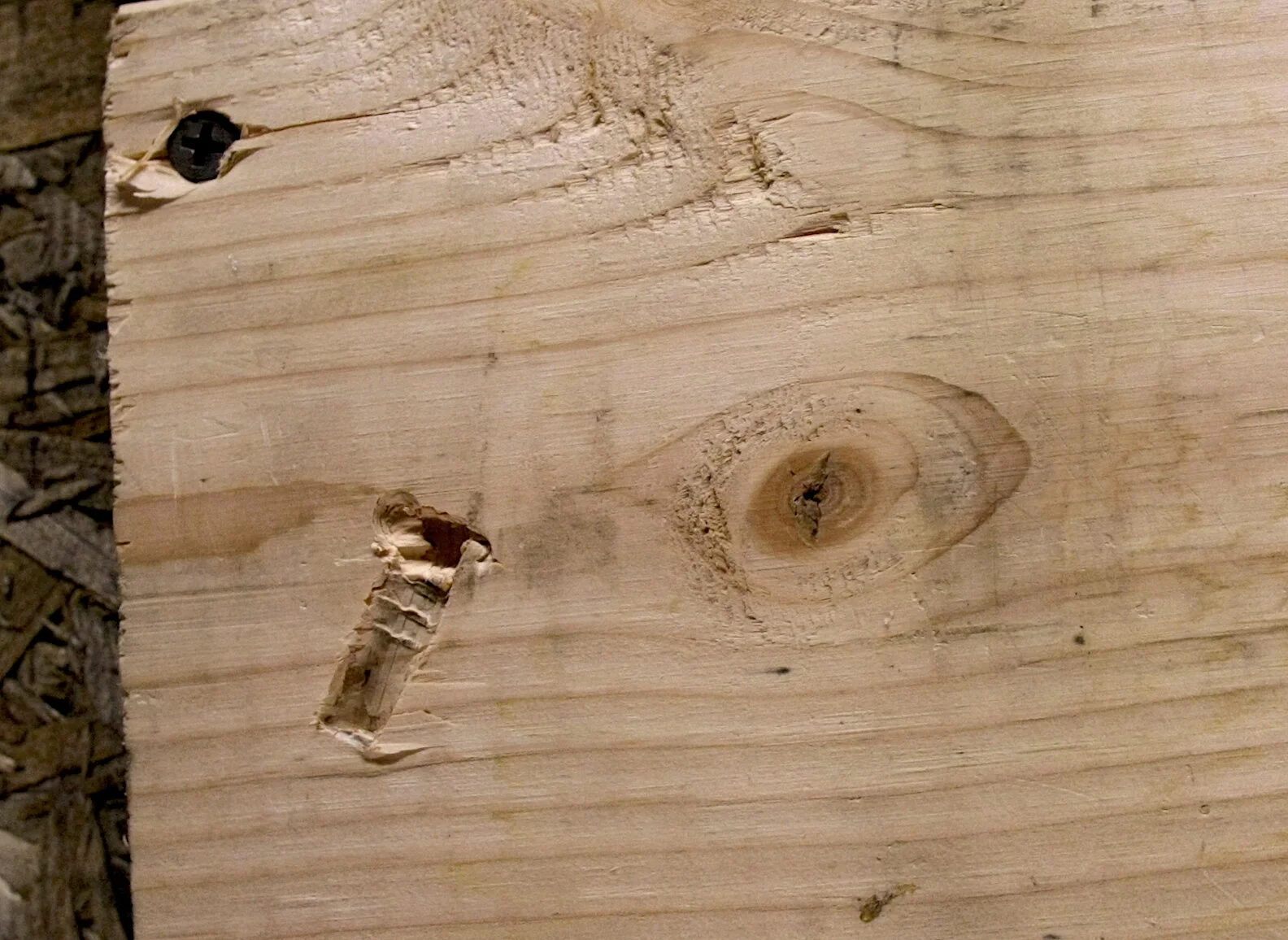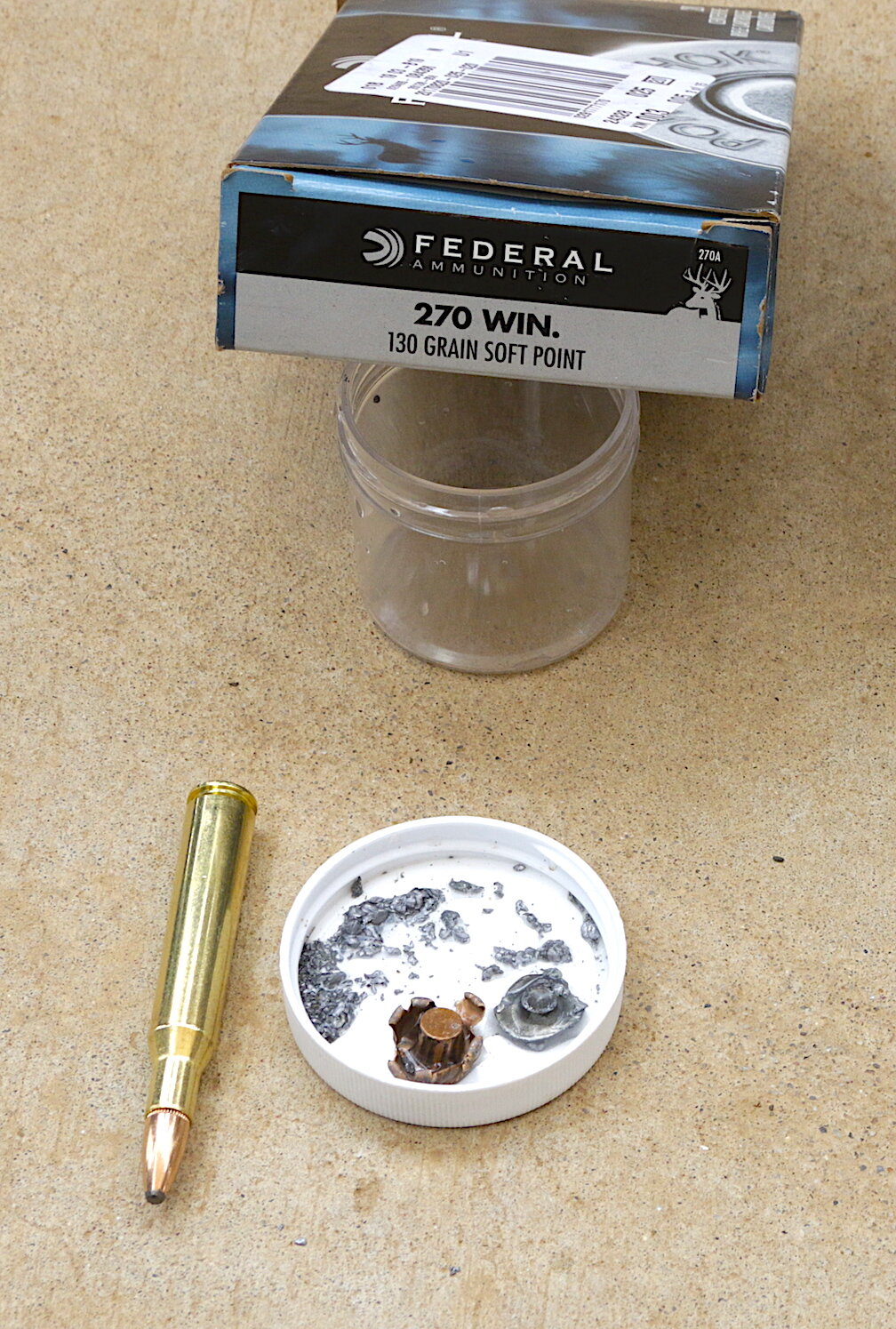28 Years Hunting With Barnes X Bullets
I started hunting with Barnes all-copper X Bullets about 28 years ago, loading them in calibers from .224 through .458. Because many hunters remain confused about these bullets, perhaps even mystified, I thought I’d try to provide some clarity.
First, Barnes Bullets are not perfect. They are not the optimum bullet for all things or all times. Nor do they always deliver the fastest kills.
Second, Barnes Bullets are some of the most consistent performers I’ve ever thrown into game. As you progress through this report you’ll understand why.
Third, Barnes (alas!) is not paying me so much as a penny to write this, although they have donated many bullets for my testing and use over the years. But then so have most bullet makers.
Barnes Basics
The basic idea behind the monolithic Barnes X is to mimic traditional bullet nose expansion of good lead core bullets without the traditional fragmentation or separation of core and jacket. Such dissolution of the bullet reduces penetration to varying degrees. The X is designed to maximize penetration while expanding 1.5- to 2X original diameter.
The manner in which the various X bullets do this is via liquid (muscle tissue, lung tissue, blood, etc.) entering the hollow nose cavity. The resultant pressure forces the bullet nose to peel open along the four longitudinal creases or grooves inside that cavity. (Or maybe that X-shaped cavity is pressed around a mandrel.)
Classic Barnes X Bullet expansion on game.
The diameter and depth of the hollow determines how far back the petals peel and at what impact velocities. The minimum for expansion is generally about 1,800 fps. X Bullets designed for low velocity cartridges like lever-action rifle and revolver rounds and even 30-30 Winchester show larger nose openings than those made for high velocity centerfire rifle cartridges., so they open at much lower velocities.
Light and Long B.C. Issues
Because the specific gravity of copper is less than that of lead, a Barnes X the same weight as a similarly shaped lead-core bullet will be much longer; so long that it might not stabilize in standard twist rate barrels. If your 270 stabilizes a 150-grain traditional bullet, it will likely stabilize no heavier than a 140-grain TTSX. Fortunately, the 90- to 100-percent terminal weight retention of Barnes X bullets compensates for this lighter mass. In general, a Barnes X one or two weight steps down from comparable cup-and-lead core bullets penetrates as well. Thus a 165-gr. or even 150-gr. .308 X could match the penetration of a 180-gr. lead core from the same cartridge. This does not apply to bonded or partitioned lead cores. And controlled expansion lead core bullet that routinely holds onto 80% or more of original mass should penetrate as well as or better than the lighter X.
One downside to the various Xs — even the new LRX optimized for ballistic efficiency — is that they cannot match the B.C. of maximally shaped lead-core projectiles. This is because mass or weight is a major contributor to B.C. A Barnes X built to match the B.C. of, say, a Berger VLD of the same caliber would be so long that a hyper-fast rifling twist would be needed to stabilize it.
An all-copper X Bullet of a given weight is much longer than a lead core of the same weight.
On the flip side, the lighter weight of the Barnes allows it to be driven faster, increasing muzzle energy and flattening trajectory to at least the 500-yard-line. Increased MV also offsets wind deflection, though not as much as higher B.C. would.
Here’s how I sum up the light and long issue: it’s a wash with most cartridges at “responsible” hunting ranges. Out to 300 yards there may be a 1-inch drop and drift advantage to the higher B.C. lead core bullet of the same weight. At 500 yards there’s perhaps a 2- to 3-inch advantage to lead.
Step down in weight for the Barnes and you’ll likely shoot flatter while wind deflection at 300 yards suffers an inch or so more than the competing, heavier lead-core bullet. (See ballistic charts below.) Comparing the 110-gr. TTSX against the 130-gr. Interbond at 500 yards shows the TTSX dropping 2.5 inches LESS while the Interbond deflects about 3 inches less.
Opening Up About Barnes Bullet Expansion
A persistent complaint — or is it misconception? — about Barnes is that they don’t always “open up” or expand. Well, of course every bullet at some point is going to “zip through like a solid” or open too soon or too much… or something. But does the tiny nose opening on a Barnes TSX make it less likely to expand?
Even with that tiny nose opening, Barnes X Bullets reliably expand. Not 100% reliable but as consistent as any bullet I’ve closely observed over 28 seasons.
One would think so, but that’s not been my experience. I think a lot of rumors about failure to expand result when a hunter sees a small exit hole in the side of his dead deer or elk and assumes that means the bullet didn’t open. I’ve seen that on a lot of my animals, but examination of the thoracic cavity has almost always revealed significant to massive tissue damage. But…
I’ve twice had X Bullets fail to expand. Once on a whitetail, one on a mule deer, both with 140-grain original Xs back in the mid-1990s. Both deer behaved as if hit with a solid and required 2nd shots to put down. Post mortem evidence pointed to minimum or no expansion. I spoke with Barnes about it and they said that batch/lot had been farmed out for manufacture to a Korean operator who (Barnes said) did not adhere to manufacturing tolerances in one way or another. Whether true or a deflection I don’t know. I doubt the Barnes folks would have lied to me. They’ve always struck me as forthright and honest. Nonetheless, subsequent 140-grain .284s and all other Barnes bullets I’ve taken game with opened reliably and quickly. Except one. Here’s what happened with that…
I targeted a big (there he is on my wall now!) waterbuck with a Texas heart shot, figuring my 165-grain TTSX would penetrate deeply enough to win the case. The struck bull stumbled forward into a thicket. I approached to administer the coup d’grace through a tangle of small branches, figuring the monolithic Barnes would plow through the wood. It did, but the bullet hole in the hide was elongated. The bullet had been not just deflected by a branch, but deflected in such a way that its tip was squeezed shut and it hit the bull sideways. Upon impact with the bull’s shoulder, it was bent into a banana shape, yet penetrated far enough to do its job.
Here’s the 165-grain .308 TSX bullet pulled from waterbuck bull shot in a brush thicket. We assume the tip hit a branch, closing the tip. The bullet then turned sideways, entered the bull’s shoulder, tearing the vitals, and stopping in the far shoulder.
Here is the waterbuck killed by the banana bullet.
Over the years Barnes went to considerable length to demonstrate how easily and quickly its bullets expanded. Search You Tube and you should find videos showing various X Bullets hitting ballistic gelatin and even apples and emerging fully expanded. At least one independent study revealed a 130-grain TTSX .277 at impact velocity of 1,800 fps exited a 1.5” thick slab of ballistic wax and punched through a 1/4” aluminum plate. The hole in the plate was .445”, indicating the bullet had expanded 0.168” in diameter or a little more than 1.5X. And this was at what Barnes calls its minimum impact velocity, something the 270 Win. carries to at least 600 yards.
My personal observations while afield taking everything from 30-pound coyotes and 12-pound Damara dik dik to 1,300-pound Cape buffalo and 1,800-pound eland corroborate those tests.
Don’t They Shoot Through and Waste Energy?
Barnes bullets usually shoot through broadside. Do not flock shoot. Be sure there is nothing you don’t want to hit beyond your target animal.
There is a common misperception that the more energy a bullet “dumps” in an animal, the faster and more thoroughly it will be killed. This “theory” has been disproven many times in various ways. The easiest thought experiment to help understand the “energy kills” myth is colliding football players. At speed and weighing 225-pounds or so, two humans coming together at 10 mph make for a dramatic crash equal to the energy in a 130-grain .270 bullet at 100 yards. But as proven every Sunday in November, this energy is absorbed and shrugged off by the football players.
Another example: consider launching a resilient, two-pound bag of gelatin at 100 fps. That yields about the same energy as a 22 Win. Mag. launching a 40-grain bullet. While you’ll absorb all 310 f-p of energy from the gel bag, I doubt it will kill you. The 40-grain bullet with about 320 f-p? I wouldn’t want to get hit by it. But it’s not the energy that’s dangerous. It’s the physical work done by the projectile carrying the energy. Ripping, tearing, cutting.
So how does this apply to Barnes X Bullets zipping right through? While passing through — regardless how much energy its carrying — the bullet rips and tears tissue to break vital organs and create massive hemorrhaging. Whether it emerges to bury 3 f-p or 3,000 f-p in the dirt doesn’t matter. It’s already done its work! But if you need more evidence…
We tested the “wasted bullet energy” theory in Barnes’ labs in Utah, driving 180-grain .308 bullets into 24-inch blocks of ballistic gelatin to emerge out the back. Chronographs front and back measured entry and exit speeds. We did the math and discovered the emerging bullets “wasted” less than the 140 f-p energy of a 22 long rifle. One measurement was 24 f-p, as I recall. I also remember the bullets putting dents into a pine board behind the gelatin. Just dents.
Here’s the “wasted” energy of a 180-gr. Barnes shot from a 300 RUM through a 24” block of ballistic gelatin. The bullet was moving so slowly it was tumbling and carrying about 24 f-p energy.
Barnes X Bullet All Fouled Up!
blue patch photo
Copper fouling has been a frequent complaint against Barnes. Yes, the original X Bullets had long shanks that increased contact and friction with bores. Relief grooves or bands on the TSX, TTSX, and LRX have solved that issue. I find little or no more copper fouling with these bullets than more traditional cup-and-cores.
Chamber Pressures Climb too High with Barnes
This was another problem of the original X in the 1990s. The relief grooves have solved it. I routinely use the same handloading data with TSX and TTSX bullets as traditional gilding metal/lead core bullets.
Barnes Bullets are Inaccurate
My Rifles, Inc. in 280 AI had no quarrel with original X bullets.
There was some truth to this with the original generation because those long, solid copper shanks did not obdurate to match varying barrel dimensions. Your barrel either liked them or didn’t. Relief bands on modern Xs seem to have solved this issue. Cartridge to cartridge, barrel to barrel I find no more nor less accuracy with various Barnes than any other well balanced, quality bullet. In fact, the consistency of the solid copper probably makes it easier to create a balanced X bullet than any lead core bullet. No air bubbles or gaps between jacket and core. No varying thicknesses of jacket.
Game Runs Forever When Hit With Barnes
Not quite. I have noticed that chest-shot deer and various antelope — moose too — sometimes run a bit farther after a solid chest hit with a Barnes than with more frangible bullets, especially varmint-style bullets that “explode” like grenades within the chest cavity. Those usually kill quickly. But with the Barnes I don’t have to worry about a frangible bullet failing to penetrate adequately. And I generally get a big hole on the far side for blood trailing.
I can also rely on Barnes bullets to drive a fairly straight path plus reach and break bones on the off shoulder. I don’t recommend hunters routinely take north-south shot angles nor steeply angled shots toward the heart, but these are doable with Barnes bullets. Just don’t do what I once did and take a behind-the-last-rib-forward shot with a 270 Winchester after you switched from your TTSX load to a cup-and-core bullet! That buck went a long, long way before it expired. By the time we found it the coyotes already had.
Lead-Free Dinner
This is what a typical cup-and-core bullet looks like after impacting three gallon-sized milk jugs at 100 yards. This is not a condemnation of the Federal bullet. All cup-and-cores behave like this.
There is plenty of argument over lead contamination from bullets. I don’t know the absolute answer regarding human health. History suggests humans have been eating lead-killed game for several hundred years and we haven’t gone extinct yet. But lead poisoning from gasoline, paint, etc. has been a known problem for decades. Effects can be subtle. How do you know if your low IQ is a result of poor genetics or childhood lead poisoning that hampered brain development? For all I know I could be a rocket scientist save for all those lead shot pheasants I ate.
Seriously, lead fragments in carcasses are a proven killer of scavengers, especially birds of prey. Eagles, various hawks, condors, but even chickadees, nuthatches, woodpeckers — lots of birds eat fat and meat and ingest the tiny flecks of lead that can expand as far as 18-inches from the primary bullet cavity. I’ve seen X-rays of this.
Frangible lead-core bullets kill quickly if they enter the thoracic cavity, but — as this wax test medium shows — tiny bits of lead are scattered far and wide.
Bonded lead cores reduce fragmentation, but when I weigh a recovered bonded bullet and discover it has lost 10, 20, or 30 grains — well, that lead had to have gone somewhere. I assume it eroded as a smear of lead on the muscle. Something is going to eat that muscle.
The truth is that, although lead poisoning like this has been documented killing many birds and even some mammals, there is no evidence that it is jeopardizing any populations except condors. Bald eagles have been increasing for years. Biologists have even credited hunter killed game as contributing to eagle survival even while poisoning some. Nevertheless, taking a flippant, who cares attitude to this collateral damage does nothing for the public image of hunters. Something to consider.
When Barnes Bullets Fail!
If you want to regularly engage game beyond 500 yards, you probably do not want Barnes bullets. The recommended minimum 1,800 fps barrier usually falls between 500 and 600 yards. And let me be honest. A minimum impact speed of 2,000 fps is probably a better standard. They will start to open at 1,800 fps. They just won’t necessarily open fully, the petals folding back to the complete depth of the nose cavity. Betsy once shot a Cape buffalo on the shoulder from an estimated 125- to 140-yard distance with a 375 H&H driving a 300-grain TSX about 2, 400 fps. Impact velocity was around 2,000 fps and the bullet was expanded about half of full expansion. We found that bullet against the offside hide. The good news is that bull, despite having no support bone broken and the heart intact, could not get up. It was a rather strange thing given the reputation for buffalo taking a licking and keeping on ticking. But we didn’t complain. Barnes TTSX 1, buffalo 0.
Betsy’s buffalo bullet.
Final Answer
Don’t be afraid to try Barnes bullets. Not even in small calibers. Not even on small animals. I once applied a 75 grain X from a 6mm Remington to the chest of a whitetail buck. It nosed dived after a ten-yard dash. During a 1995 safari I went 12 for 14 (all hits) on African antelope with 210-grain .338 X bullets. My PH declared them the most effective killers he’d ever seen. My first Mozambique guide described them as a soft point and solid in one bullet.
None of this means X Bullets are foolproof. You still have to put the bullet in the right place. And even then, sometimes the impossible becomes possible and your prey escapes. I’ll never figure out how a South African warthog absorbed two 300 grain TSX to the chest from my 45-70, ran 300 yards, and was still able to jump and run when I walked up. It took one more through the chest before that hog finally gave up. I guess with game the impossible is possible. But Barnes X bullets reduce the possibility of the impossible about as well as can be expected.












